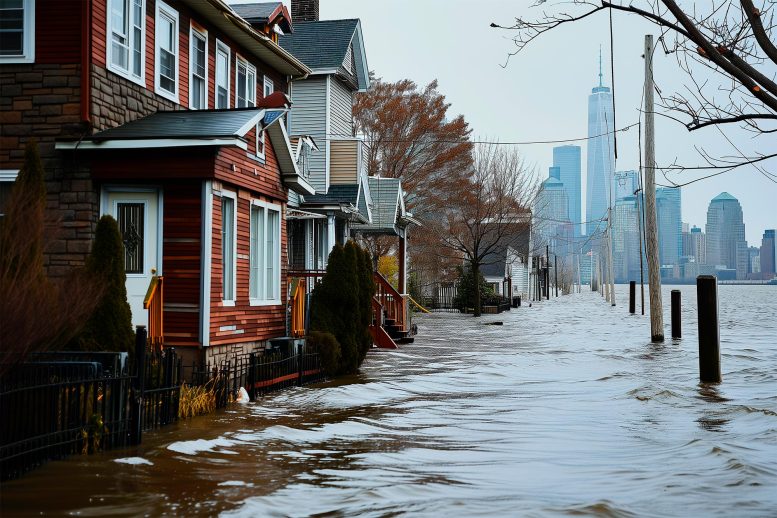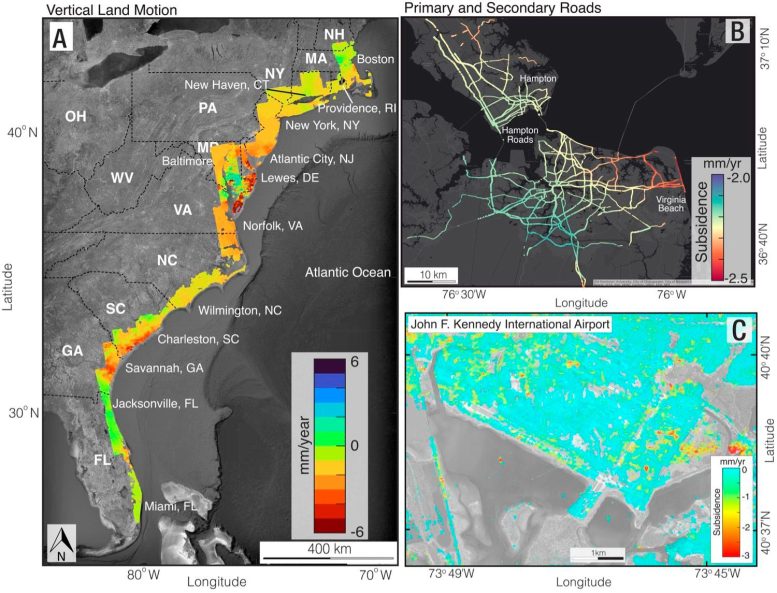
A study reveals subsidence issues on the U.S. East Coast, affecting over 2 million people and numerous infrastructures. Areas like Norfolk, Baltimore, and parts of New York City are particularly impacted. The study emphasizes the urgency for policy intervention due to potential risks to densely populated and property-rich regions. Credit: SciTechDaily.com
The East Coast of the U.S. is sinking, impacting major cities and infrastructure, with a significant population at risk. A new study calls for urgent policy action to mitigate potential damages.
The Sinking East Coast: A Rising Concern
A significant portion of the U.S. East Coast is experiencing subsidence, a phenomenon where land gradually sinks. Within this area, a smaller region spanning up to 3,700 km2 (1,400 miles2) is sinking at an alarming rate of more than 5 mm (0.2 inches) per year. This subsidence poses serious threats including undermining building foundations, damaging roads, gas and water lines, causing building collapses, and worsening coastal flooding in conjunction with sea level rise due to climate change.
Estimating Risks and Affected Areas
Leonard O. Ohenhen and his team utilized radar satellite datasets to measure vertical land motion rates. Their goal was to identify which areas, populations, and infrastructures within 100 km (62 miles) of the U.S. East Coast are at risk. They found that subsidence rates of 2 mm per year are affecting up to 2.1 million people and 867,000 properties. Several communities such as Norfolk, VA; Virginia Beach, VA; Baltimore, MD; and areas in New York City including Queens, the Bronx, and Long Island, are seeing over 60% of their land area sinking. This subsidence impacts various critical infrastructures, including roads, railways, airports, and levees.

Vertical land motion on the US East Coast (left); primary, secondary, and interstate roads in Hampton Roads, VA (top right), and JFK Airport (bottom right). Note that the yellow orange and red areas on these maps indicate sinking. Credit: Leonard Ohenhen
Infrastructure at Risk: Airports and Beyond
The study highlighted specific examples of infrastructure at risk, such as JFK and LaGuardia airports in New York, where numerous areas, including the runways, are sinking at rates exceeding 2 mm per year. Subsidence is often caused by groundwater extraction or sediment compaction. Interestingly, some cities are experiencing a rise due to the North American continent rebounding from the weight of glaciers during the last glacial period, about 10,000 years ago.
Chesapeake Bay: A Mixed Scenario
Around the Chesapeake Bay, the land shows a patchy mix of rising and falling areas, leading to a medium–high risk of differential subsidence. This type of subsidence can cause angular distortion between two adjacent points, potentially tearing structures apart over time.
Policy Implications and Future Concerns
The authors highlight that there is no universally accepted subsidence threshold that triggers concern among policymakers and citizens. However, they stress the importance of addressing this issue, especially given the high population density, property density, and general complacency towards infrastructure maintenance on the East Coast. Continuous, unmitigated subsidence could lead to severe problems in the future.
For more on this research, see Major East Coast Cities Including NYC and DC Rapidly Sinking.
Reference: “Slowly but surely: Exposure of communities and infrastructure to subsidence on the US east coast” by Leonard O Ohenhen, Manoochehr Shirzaei and Patrick L Barnard, 2 January 2024, PNAS Nexus.
DOI: 10.1093/pnasnexus/pgad426









So we need water credits like carbon credits and mega water capture/sequestration projects costing trillions. Free market
capitalism would automatically handle climate/environment
problems without creating big brother government.